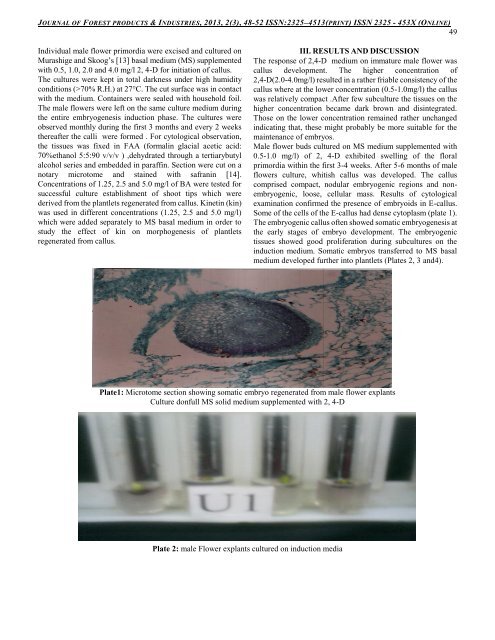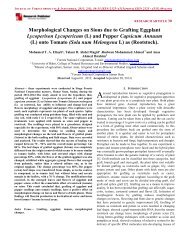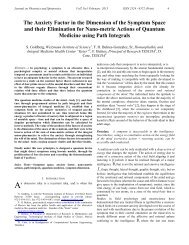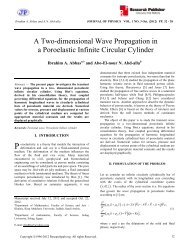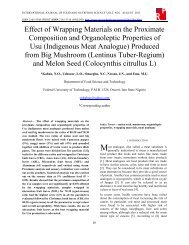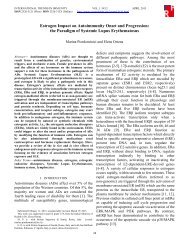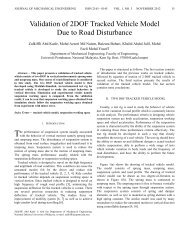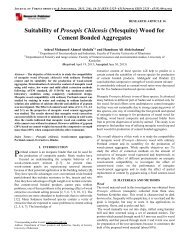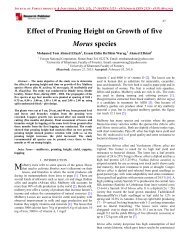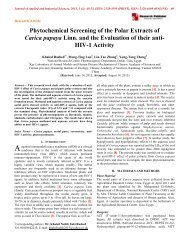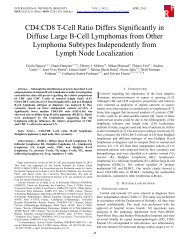Embryogenesis and Plantlet Regeneration via Immature Male ...
Embryogenesis and Plantlet Regeneration via Immature Male ...
Embryogenesis and Plantlet Regeneration via Immature Male ...
You also want an ePaper? Increase the reach of your titles
YUMPU automatically turns print PDFs into web optimized ePapers that Google loves.
JOURNAL OF FOREST PRODUCTS & INDUSTRIES, 2013, 2(3), 48-52 ISSN:2325–4513(PRINT) ISSN 2325 - 453X (ONLINE)49Individual male flower primordia were excised <strong>and</strong> cultured onMurashige <strong>and</strong> Skoog’s [13] basal medium (MS) supplementedwith 0.5, 1.0, 2.0 <strong>and</strong> 4.0 mg/l 2, 4-D for initiation of callus.The cultures were kept in total darkness under high humidityconditions (>70% R.H.) at 27°C. The cut surface was in contactwith the medium. Containers were sealed with household foil.The male flowers were left on the same culture medium duringthe entire embryogenesis induction phase. The cultures wereobserved monthly during the first 3 months <strong>and</strong> every 2 weeksthereafter the calli were formed . For cytological observation,the tissues was fixed in FAA (formalin glacial acetic acid:70%ethanol 5:5:90 v/v/v ) ,dehydrated through a tertiarybutylalcohol series <strong>and</strong> embedded in paraffin. Section were cut on anotary microtome <strong>and</strong> stained with safranin [14].Concentrations of 1.25, 2.5 <strong>and</strong> 5.0 mg/l of BA were tested forsuccessful culture establishment of shoot tips which werederived from the plantlets regenerated from callus. Kinetin (kin)was used in different concentrations (1.25, 2.5 <strong>and</strong> 5.0 mg/l)which were added separately to MS basal medium in order tostudy the effect of kin on morphogenesis of plantletsregenerated from callus.III. RESULTS AND DISCUSSIONThe response of 2,4-D medium on immature male flower wascallus development. The higher concentration of2,4-D(2.0-4.0mg/l) resulted in a rather friable consistency of thecallus where at the lower concentration (0.5-1.0mg/l) the calluswas relatively compact .After few subculture the tissues on thehigher concentration became dark brown <strong>and</strong> disintegrated.Those on the lower concentration remained rather unchangedindicating that, these might probably be more suitable for themaintenance of embryos.<strong>Male</strong> flower buds cultured on MS medium supplemented with0.5-1.0 mg/l) of 2, 4-D exhibited swelling of the floralprimordia within the first 3-4 weeks. After 5-6 months of maleflowers culture, whitish callus was developed. The calluscomprised compact, nodular embryogenic regions <strong>and</strong> nonembryogenic,loose, cellular mass. Results of cytologicalexamination confirmed the presence of embryoids in E-callus.Some of the cells of the E-callus had dense cytoplasm (plate 1).The embryogenic callus often showed somatic embryogenesis atthe early stages of embryo development. The embryogenictissues showed good proliferation during subcultures on theinduction medium. Somatic embryos transferred to MS basalmedium developed further into plantlets (Plates 2, 3 <strong>and</strong>4).Plate1: Microtome section showing somatic embryo regenerated from male flower explantsCulture donfull MS solid medium supplemented with 2, 4-DPlate 2: male Flower explants cultured on induction media


